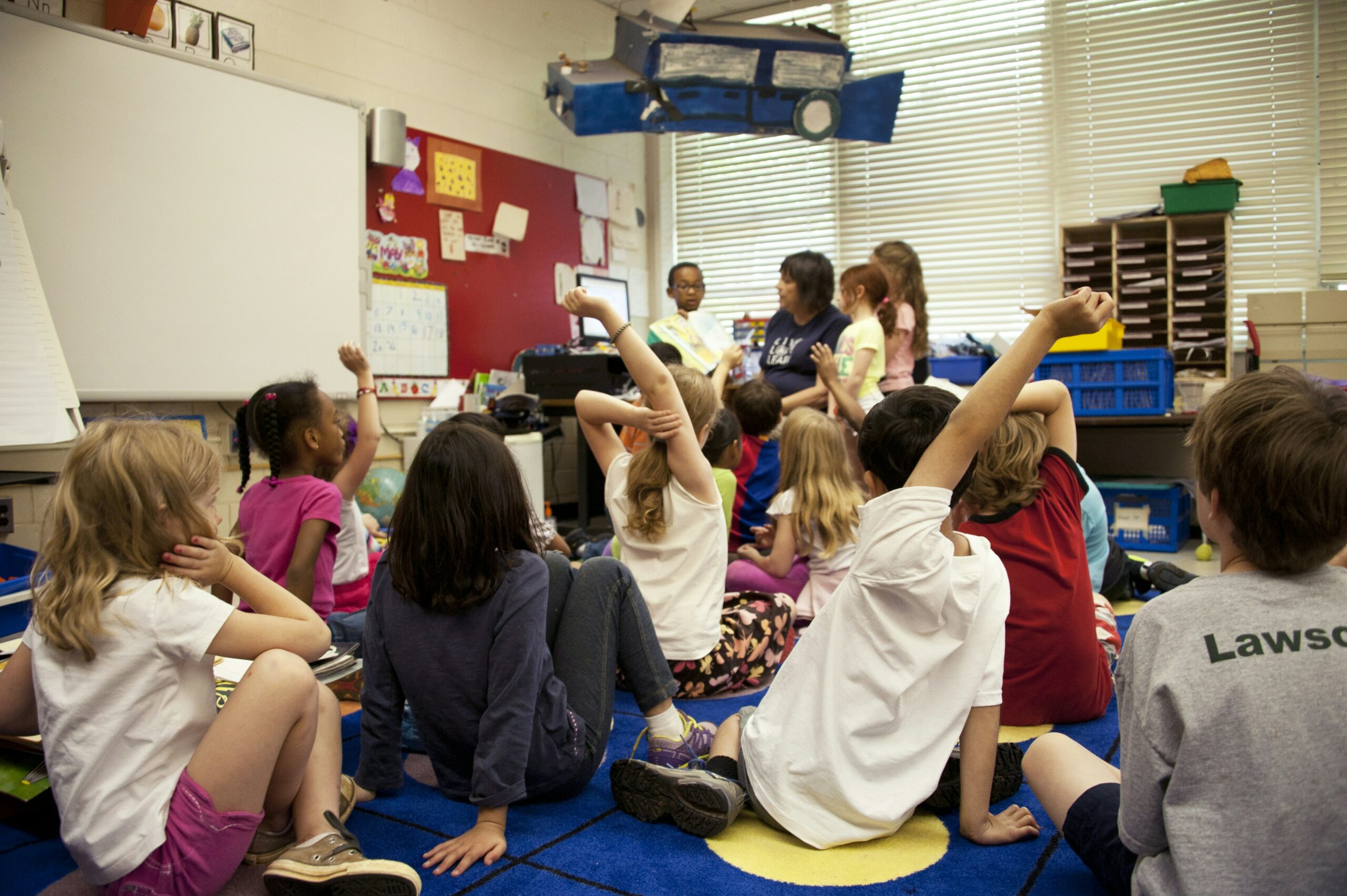
This essay is an edited and web-adapted version of an original essay for the University of Amsterdam’s Bachelor’s Psychology Program- Specialisation Clinical Developmental Psychology, Childhood- Developmental Psychology course in March 2023, coordinated by Dr. B.R.J. (Brenda) Jansen.
This essay is an edited and web-adapted version of an original essay for the University of Amsterdam’s Bachelor’s Psychology Program- Specialisation Clinical Developmental Psychology, Childhood- Developmental Psychology course in March 2023, coordinated by Dr. B.R.J. (Brenda) Jansen.
The Implementation of Inclusive Education
As research progresses in the field of developmental psychology, it becomes increasingly evident that there is no ‘one-size-fits-all’ solution for how to provide optimal opportunities and environments for the development of children. One such example is the issue of how to make education accommodating, effective, and inclusive for all. Classrooms have a wide range of individual differences in children, including their capabilities, challenges, and specific needs. In the context of intellectual abilities, a classroom can include children with intellectual disabilities (ID), a label for individuals with suboptimal intellectual functioning, typically an IQ below 70, and deficits in adaptive functioning; It is not a medical or psychiatric diagnosis yet there are distinctions between mild, moderate, and severe ID (Wilmhurst, 2015). The long-standing debate about whether segregated special education programs or mainstream education is more beneficial for ID populations is yet to be resolved, with claims that mainstream education does not cater to specific academic concerns, to the importance of having intensive and individualized instructions (Wilmhurst, 2015). These claims can be extended to the other end of the spectrum when considering ‘gifted’ students. According to the APA Dictionary (2015), giftedness refers to a considerable natural talent, ability, or intelligence, typically an IQ of 130 or above, that becomes evident from a young age. When considering children with ID, gifted children, and the children that fall in between, it is important to study the ways to accommodate individual differences in one classroom; whether this is possible based on research and what is happening in classrooms today.
Finklestein, Sharma, and Furlonger (2019) formulated a framework to help guide teachers toward an inclusive classroom with five domains that need to be fulfilled: collaboration and teamwork, a method to determine progress, instructional support, organizational practices in terms of how the classroom is set-up, and social/emotional/behavioral support. Teacher competence and willingness in applying these domains play a role in the success of an inclusive classroom, hence, this essay will delve into the well-researched domains of collaboration and teamwork together with instructional support from the perspectives of teachers, students with ID, and gifted students.
First and foremost, it is critical to address the assumption that inclusive education is more beneficial than segregated education for both students with ID and gifted students. Following the United Nations Convention for the Rights of Persons with Disabilities (UNCRPD) fuelling efforts to make education inclusive for all in 2007, there were increased enrollments of children with disabilities in general education internationally. Nevertheless, children with ID seem to have remained in Special Educational Needs (SEN) schools (Buchner et al., 2021). This is a concerning statistic, as research shows that the social competence of children with moderate ID develops better than when they are in inclusive education programs rather than segregated programs (Hardiman, Geurin & Fitzsimmons, 2009). Similarly, the psychological well-being of gifted students in pull-out (inclusive) programs compared to typically developing children showed lower scores for maladaptive perfectionism and loneliness than when students in self-contained (segregated) gifted programs were compared to the typically developing population (Cash & Lin, 2022). However, children in both types of gifted programs showed higher scores on maladaptive perfectionism and loneliness than the typically developing children, suggesting there could be risks involved with simply having a ‘gifted’ label. Outside of how to accommodate individual differences in the classroom, it is essential to consider the impact of labeling abilities on psychosocial well-being. There are several methods used in inclusive education practices that can become the classroom norm as all classrooms are diverse, allowing students to be treated the same without placing pressures or expectations. Applying the guiding framework for successful inclusive education, these findings show that, in comparison to segregated programs, inclusive education programs are better supported for the socioemotional development of children. Furthermore, promoting integrated classrooms will allow students to be more open-minded, tolerant, and equipped to form successful social relations.
Alongside socio-emotional development, the ability to cater to the different intellectual abilities in the classroom is vital. As mentioned prior, instructional support is a well-researched domain in the inclusive education framework for both the ID student and gifted student population. A popular method is differentiated instruction (DI), which functions on a macro level with teachers creating lesson plans and activities that can be modified to accommodate individual needs while addressing group-specific goals (Lindner & Schwab, 2020). A study by Ziernwald, Hillmayr, and Holzberger (2022) reviewed the impact of DI on gifted students through a systematic analysis. The impact was assessed using the academic achievement and motivational/affective characteristics of the students. The review found that students had a positive attitude towards the idea of DI, particularly, students found mixed-ability grouping productive in socio-emotional development and high-achieving grouping was beneficial for academic development. This emphasizes that differentiated and individualization methods are well-received by students to optimize education, as discussed in the guidance framework.
However, there appear to be discrepancies in the implementation of DI, with teachers expressing a lack of resources, lack of knowledge on how best to enforce DI, misconceptions that DI is not necessary as gifted students are few in number, and worries that educational standards would not be met due to inflexible aspects of curricula. These findings imply that while students are enthusiastic to find more engaging and individualized educational designs, logistical needs are yet to be met to make this successful. The teacher attitudes about logistics and implementation expressed in the study extend to teaching children with intellectual disabilities as well, highlighted in the thematic analysis by Lindner and Schwab (2020) noting the difficulties in individual modification based on assessment and content while still trying to ensure the overarching group learning goals are met. Notably, these findings are not corroborated by the opinions of students with intellectual disabilities, as many studies only focus on teacher perspectives rather than how students receive the various methods. This is alarming as students with intellectual disabilities are on the receiving end of learning and could have varying opinions to the teachers as do the gifted students. Moreover, research shows discrepancies between student and teacher perceptions, with only a small overlap, arguing that perhaps teachers fall into self-serving biases when engaging in self-reports about their teaching practices (Lindner & Schwab, 2020). Thus, it is important for students to be able to have a say in what works for them and what does not so education can be altered to suit their needs, rather than what is logistically possible.
Inclusive education evidently has its merits when implemented efficiently, allowing optimal social and emotional development in the classroom and having methods to engage students of all backgrounds and abilities. Using the guidance framework can allow educators to evaluate their lesson plans and classroom methods to assess the realization of an inclusive classroom. However, this paints an optimistic picture as it is evident that currently teachers and schools do not have the resources and often the knowledge of how best to implement modifications that can cater to every individual. Future research needs to gather input from students and specify the difficulties teachers are experiencing to advise student support staff on inclusive educational practices. Furthermore, future research must be done on the impact of labels on the psychosocial well-being of students, as individualized and differentiated education has the potential to become the classroom standard instead of a specific practice, if labels alluding to individual abilities are detrimental to mental health. Working with educators to accommodate individual differences in the classroom while optimizing the development of children by providing teachers with the knowledge and resources they need to do their jobs effectively will make inclusive education a reality.
References
-
American Psychological Association. (2015). APA Dictionary of Psychology (2nd ed.).
-
Buchner, T., Shevlin, M., Donovan, M. A., Gercke, M., Goll, H., Šiška, J., … & Corby, D. (2021). Same progress for all? Inclusive education, the United Nations Convention on the rights of persons with disabilities and students with intellectual disability in European countries. Journal of Policy and Practice in Intellectual Disabilities, 18(1), 7-22.
-
Cash, T. N., & Lin, T. J. (2022). Psychological well-being of intellectually and academically gifted students in self-contained and pull-out gifted programs. Gifted Child Quarterly, 66(3), 188-207.
-
Finkelstein, S., Sharma, U., & Furlonger, B. (2021). The inclusive practices of classroom teachers: a scoping review and thematic analysis. International Journal of Inclusive Education, 25(6), 735-762.
-
Hardiman, S., Guerin, S., & Fitzsimons, E. (2009). A comparison of the social competence of children with moderate intellectual disability in inclusive versus segregated school settings. Research in Developmental Disabilities, 30(2), 397-407.
-
Lindner, K. T., & Schwab, S. (2020). Differentiation and individualisation in inclusive education: a systematic review and narrative synthesis. International Journal of Inclusive Education, 1-21.
-
Wilmshurst, L. (2015).Chapter 4. Intellectual and Developmental Disabilities. In Essentials of child and adolescent psychopathology, p. 73-84. Wiley.
-
Ziernwald, L., Hillmayr, D., & Holzberger, D. (2022). Promoting High-Achieving Students Through Differentiated Instruction in Mixed-Ability Classrooms—A Systematic Review. Journal of Advanced Academics, 33(4), 540-573.
The Implementation of Inclusive Education
As research progresses in the field of developmental psychology, it becomes increasingly evident that there is no ‘one-size-fits-all’ solution for how to provide optimal opportunities and environments for the development of children. One such example is the issue of how to make education accommodating, effective, and inclusive for all. Classrooms have a wide range of individual differences in children, including their capabilities, challenges, and specific needs. In the context of intellectual abilities, a classroom can include children with intellectual disabilities (ID), a label for individuals with suboptimal intellectual functioning, typically an IQ below 70, and deficits in adaptive functioning; It is not a medical or psychiatric diagnosis yet there are distinctions between mild, moderate, and severe ID (Wilmhurst, 2015). The long-standing debate about whether segregated special education programs or mainstream education is more beneficial for ID populations is yet to be resolved, with claims that mainstream education does not cater to specific academic concerns, to the importance of having intensive and individualized instructions (Wilmhurst, 2015). These claims can be extended to the other end of the spectrum when considering ‘gifted’ students. According to the APA Dictionary (2015), giftedness refers to a considerable natural talent, ability, or intelligence, typically an IQ of 130 or above, that becomes evident from a young age. When considering children with ID, gifted children, and the children that fall in between, it is important to study the ways to accommodate individual differences in one classroom; whether this is possible based on research and what is happening in classrooms today.
Finklestein, Sharma, and Furlonger (2019) formulated a framework to help guide teachers toward an inclusive classroom with five domains that need to be fulfilled: collaboration and teamwork, a method to determine progress, instructional support, organizational practices in terms of how the classroom is set-up, and social/emotional/behavioral support. Teacher competence and willingness in applying these domains play a role in the success of an inclusive classroom, hence, this essay will delve into the well-researched domains of collaboration and teamwork together with instructional support from the perspectives of teachers, students with ID, and gifted students.
First and foremost, it is critical to address the assumption that inclusive education is more beneficial than segregated education for both students with ID and gifted students. Following the United Nations Convention for the Rights of Persons with Disabilities (UNCRPD) fuelling efforts to make education inclusive for all in 2007, there were increased enrollments of children with disabilities in general education internationally. Nevertheless, children with ID seem to have remained in Special Educational Needs (SEN) schools (Buchner et al., 2021). This is a concerning statistic, as research shows that the social competence of children with moderate ID develops better than when they are in inclusive education programs rather than segregated programs (Hardiman, Geurin & Fitzsimmons, 2009). Similarly, the psychological well-being of gifted students in pull-out (inclusive) programs compared to typically developing children showed lower scores for maladaptive perfectionism and loneliness than when students in self-contained (segregated) gifted programs were compared to the typically developing population (Cash & Lin, 2022). However, children in both types of gifted programs showed higher scores on maladaptive perfectionism and loneliness than the typically developing children, suggesting there could be risks involved with simply having a ‘gifted’ label. Outside of how to accommodate individual differences in the classroom, it is essential to consider the impact of labeling abilities on psychosocial well-being. There are several methods used in inclusive education practices that can become the classroom norm as all classrooms are diverse, allowing students to be treated the same without placing pressures or expectations. Applying the guiding framework for successful inclusive education, these findings show that, in comparison to segregated programs, inclusive education programs are better supported for the socioemotional development of children. Furthermore, promoting integrated classrooms will allow students to be more open-minded, tolerant, and equipped to form successful social relations.
Alongside socio-emotional development, the ability to cater to the different intellectual abilities in the classroom is vital. As mentioned prior, instructional support is a well-researched domain in the inclusive education framework for both the ID student and gifted student population. A popular method is differentiated instruction (DI), which functions on a macro level with teachers creating lesson plans and activities that can be modified to accommodate individual needs while addressing group-specific goals (Lindner & Schwab, 2020). A study by Ziernwald, Hillmayr, and Holzberger (2022) reviewed the impact of DI on gifted students through a systematic analysis. The impact was assessed using the academic achievement and motivational/affective characteristics of the students. The review found that students had a positive attitude towards the idea of DI, particularly, students found mixed-ability grouping productive in socio-emotional development and high-achieving grouping was beneficial for academic development. This emphasizes that differentiated and individualization methods are well-received by students to optimize education, as discussed in the guidance framework.
However, there appear to be discrepancies in the implementation of DI, with teachers expressing a lack of resources, lack of knowledge on how best to enforce DI, misconceptions that DI is not necessary as gifted students are few in number, and worries that educational standards would not be met due to inflexible aspects of curricula. These findings imply that while students are enthusiastic to find more engaging and individualized educational designs, logistical needs are yet to be met to make this successful. The teacher attitudes about logistics and implementation expressed in the study extend to teaching children with intellectual disabilities as well, highlighted in the thematic analysis by Lindner and Schwab (2020) noting the difficulties in individual modification based on assessment and content while still trying to ensure the overarching group learning goals are met. Notably, these findings are not corroborated by the opinions of students with intellectual disabilities, as many studies only focus on teacher perspectives rather than how students receive the various methods. This is alarming as students with intellectual disabilities are on the receiving end of learning and could have varying opinions to the teachers as do the gifted students. Moreover, research shows discrepancies between student and teacher perceptions, with only a small overlap, arguing that perhaps teachers fall into self-serving biases when engaging in self-reports about their teaching practices (Lindner & Schwab, 2020). Thus, it is important for students to be able to have a say in what works for them and what does not so education can be altered to suit their needs, rather than what is logistically possible.
Inclusive education evidently has its merits when implemented efficiently, allowing optimal social and emotional development in the classroom and having methods to engage students of all backgrounds and abilities. Using the guidance framework can allow educators to evaluate their lesson plans and classroom methods to assess the realization of an inclusive classroom. However, this paints an optimistic picture as it is evident that currently teachers and schools do not have the resources and often the knowledge of how best to implement modifications that can cater to every individual. Future research needs to gather input from students and specify the difficulties teachers are experiencing to advise student support staff on inclusive educational practices. Furthermore, future research must be done on the impact of labels on the psychosocial well-being of students, as individualized and differentiated education has the potential to become the classroom standard instead of a specific practice, if labels alluding to individual abilities are detrimental to mental health. Working with educators to accommodate individual differences in the classroom while optimizing the development of children by providing teachers with the knowledge and resources they need to do their jobs effectively will make inclusive education a reality.
References
-
American Psychological Association. (2015). APA Dictionary of Psychology (2nd ed.).
-
Buchner, T., Shevlin, M., Donovan, M. A., Gercke, M., Goll, H., Šiška, J., … & Corby, D. (2021). Same progress for all? Inclusive education, the United Nations Convention on the rights of persons with disabilities and students with intellectual disability in European countries. Journal of Policy and Practice in Intellectual Disabilities, 18(1), 7-22.
-
Cash, T. N., & Lin, T. J. (2022). Psychological well-being of intellectually and academically gifted students in self-contained and pull-out gifted programs. Gifted Child Quarterly, 66(3), 188-207.
-
Finkelstein, S., Sharma, U., & Furlonger, B. (2021). The inclusive practices of classroom teachers: a scoping review and thematic analysis. International Journal of Inclusive Education, 25(6), 735-762.
-
Hardiman, S., Guerin, S., & Fitzsimons, E. (2009). A comparison of the social competence of children with moderate intellectual disability in inclusive versus segregated school settings. Research in Developmental Disabilities, 30(2), 397-407.
-
Lindner, K. T., & Schwab, S. (2020). Differentiation and individualisation in inclusive education: a systematic review and narrative synthesis. International Journal of Inclusive Education, 1-21.
-
Wilmshurst, L. (2015).Chapter 4. Intellectual and Developmental Disabilities. In Essentials of child and adolescent psychopathology, p. 73-84. Wiley.
-
Ziernwald, L., Hillmayr, D., & Holzberger, D. (2022). Promoting High-Achieving Students Through Differentiated Instruction in Mixed-Ability Classrooms—A Systematic Review. Journal of Advanced Academics, 33(4), 540-573.



